


電車から、きれいな北鎌倉の自宅の写真をとりました。駅の仕切りの格子は自宅の木の塀と調和しています。木の塀の下に、夏の草がたくさん生えています。
I spotted this lovely Kita Kamakura house from inside the train. I like how the station uses a simple screen that echoes the house’s wood fence. I also love how the summer weeds are running rampant at the bottom of the fence.
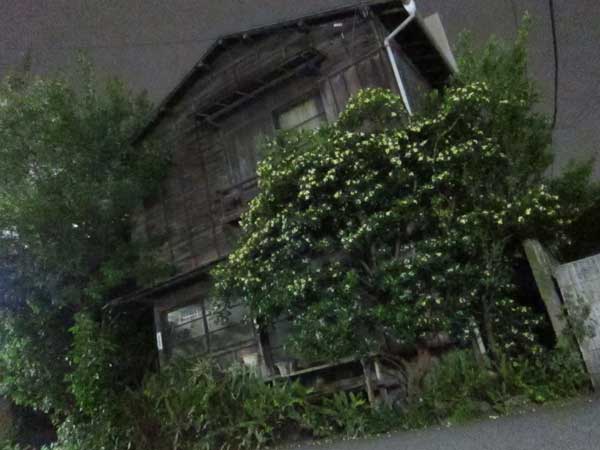
I’ve written before about this shikimi (シキミ) tree that’s thriving outside this wood house, long after it’s been unoccupied. The tree even jumped its pot, & the neighbors give it the occasional pruning to keep it out of the street.
At night and in bloom, it’s very alluring. But S warns me, “Don’t touch that poisonous tree.” Also known as Japanese star anise, the tree can be burned as incense. For tea, stick to the Chinese star anise, if you don’t want severe inflammation of the kidneys, urinary tract and digestive organs.
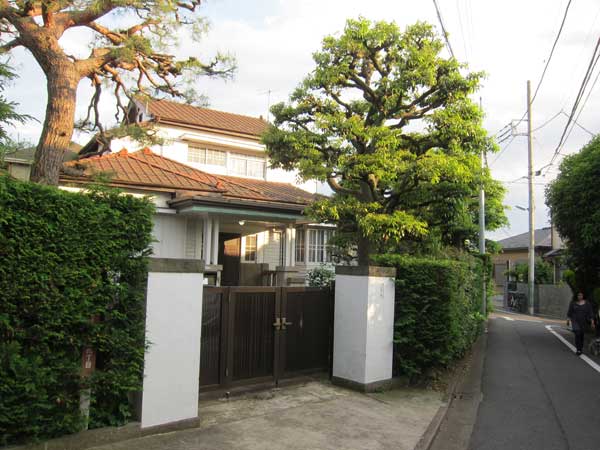
I love walking by this wood house in Suginami. It’s a relic of an earlier time: a large wooden house, mixing Western and Japanese architectural elements, and a large garden. Seeing a remnant from the past makes it easier to imagine what this area once looked and felt like. I’d like to sleep under these huge, old trees.

この素敵な盆栽はOmotesando Koffeeのオーナが作った作品です。コケが特に元気そうです。表参道に来た時はいつもこの美味しいコーヒーを飲んで、昭和モダンふうのインテリアと庭を楽しみながら、バリスタと話して行きます。
This beautiful bonsai was decorating the very chic Omotesando Koffee shop. The cafe is a modern cube inside a Showa house with a cozy front garden. The very cheerful barista explained that the owner made this bonsai himself. I like how the bonsai looks next to the cappuccino and the aged wood of the house and cupboard. The moss is especially lush and lovely.

ベランダの庭で、狭い道が混乱のなかの秩序を作ります。木の床や赤い葉やダリアや白い釉薬が対照しています。時々この小さな庭のなかで迷います。
For a brief moment, I managed to clear a long path on my narrow balcony garden. There is only the slightest order within the chaos. I like the contrast made by the wood boardwalk, the red leaves and dahlia, and the white glaze on the pots I made at Shiho ceramic studio. Sometimes I get lost within this small garden.
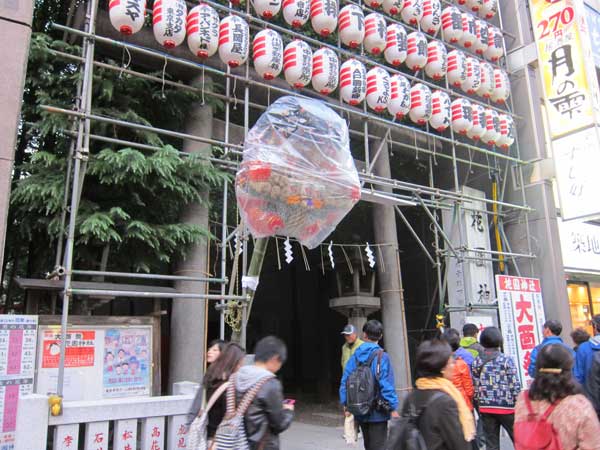
今年は酉の市が三回あります。もう熊手を買いました。同じ日に新しい仕事の契約を結びましたから、去年のよりサイズアップしました。新宿花園神社のこの祭りが大好き。たくさん水商売のオーナーが参拝にきます。でも、酉の市が三回ある年は、火事の危険が高くなると言われています。
With an entrance on Yasukuni Dori no wider than the average office building, the large Hanazono shrine in Shinjuku can easily be missed. Except in November, when the entrance is filled with lanterns and a giant rake, protected in plastic from the rain, for Tori no Ichi festival.
This festival centers around the sale of lucky rakes, made of bamboo and hot glued ornaments including rice, pine, gold coins, tai fish, and other lucky charms. One variation included all the Anpanman characters.
This year, I “sized up” from last year’s rake. The first day of the festival, I signed a new contract so I guess last year’s rake worked! I dutifully took last year’s rake back to the shrine, and added it to the pile of old rakes.
When you purchase a rake, the sellers gather around and clap wood blocks to wish you luck. I saw one rake purchased that cost 300,000 yen (yes, over US $3,000) and had to be carried by two men. Delivery is probably free when you buy such a huge one.
What makes this particular shrine fun is that all this spiritual and monetary focus caters to the Shinjuku nightlife world, as it stands in the center of Kabukicho, Golden Gai, and Ni Chome.
Because of the vagaries of the lunar year, this year there are three days this month for the festival (Nov 2, 14, and 26). There’s a superstition that when there’s three festival days, there is an increased risk of winter fires.
As fall turns to winter, I expect to hear small groups of people walking my residential neighborhood and clapping wood blocks to warn residents of the danger of fire. In the meantime, this oddly patched warning showed up at a train station. I wonder what word is underneath the English correction.
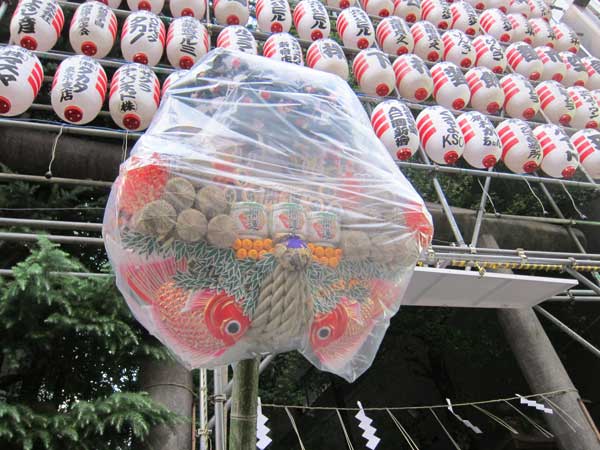
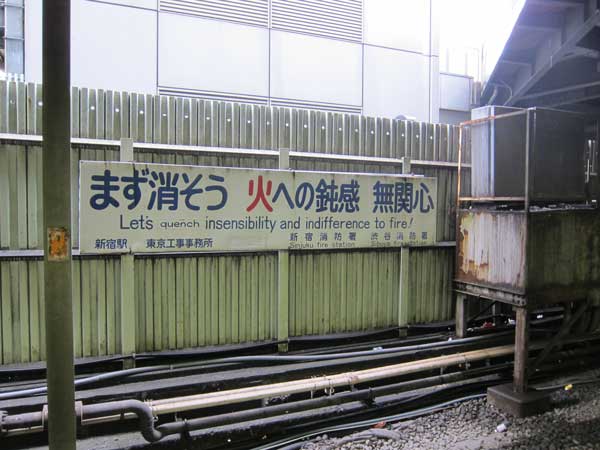

青色のサルビアと自転車と木造の家がかっこいい景色を作っています。庭というよりも、カジュアルで、気取らない、たくましい都市自然です。
Casual, unplanned, resilient. The city has a life of its own: season, history, transportation, housing, color, and mood.

最近、古いケヤキを支える木造の補助 ができました。下を歩くと、近所の方も、この補助と木を見ているのに気がつきました。2つの役割 があります。木を守るだけでなく、近所の方がこの木は特別だと気がつきます。多分、この木はこの近所で一番古い木です。木造の補助は神社の鳥居みたいです。
Recently, I’ve noticed this enormous new wood support for the giant zelkova tree in front of my local elementary school. I’ve noticed other neighbors stopping to admire the giant support and the tree.
I like how the elegant support structure protects the tree and also draws attention to its significance. This traditional style Japanese garden technique also evokes the gates outside Shinto shrines.
I’ve blogged about this landmark tree before in April and also last year. One sign says that it’s 1,000 years old. While I doubt that, it’s still a remarkable tree, and probably the oldest living being in the neighborhood.
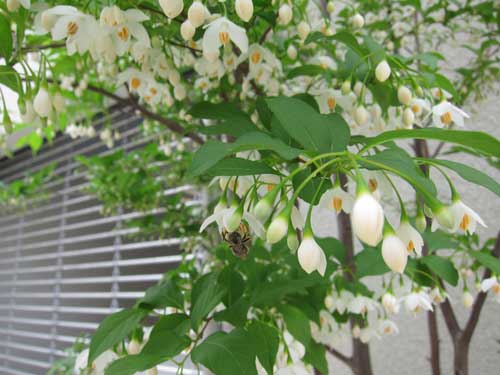
If you look in the center of the photograph, you can see a bee pollinating this Japanese snowbell tree (styrax japonicus, or エゴノキ). It is planted in the very narrow gap between a house and a small street in Nishi Azabu Juban. I learned online that the wood of this tree is used to make a string instrument called a “kokyuu,” which is similar to a shamisen.


梅雨のはじめ、雨つぶと古い見捨てられた家のあいだに、花が咲いています。
At the beginning of the rainy season, flowers bloom between raindrops and an abandoned wood house.
Between my apartment and the main road, there’s an abandoned wood house. I wrote about how the supermarket loading area guard trimmed this tree which once originated in a pot. I think it’s a pittosporum.

私のアパートの近くにきれいな木造の家があります。自然と近所の人たちのおかげで、この景色は元気です。
Just three days after the earthquake and radiation leakage, I noticed the very elderly security guard at the supermarket loading area applying a pruning saw to a tree across the alley. The tree was part of the landscape outside a beautiful abandoned wood house. The guard did a skillful pruning job. It seemed a strange gesture given the uncertainties and shortages at the time.
The wood house is one of the few pre-war structures nearby, and whatever plants are in front survive because they are extremely hardy and suited to Tokyo’s climate. Once the potted tree had been pruned back, I could see clearly that the pot was split down the middle, the roots circumventing the asphalt, and the tree naturalized in the city. The abandoned house and garden are a small neighborhood treasure. I also love the thick row of ferns, the multi-level racks with potted plants, and how the front entrance has turned into a small jungle.
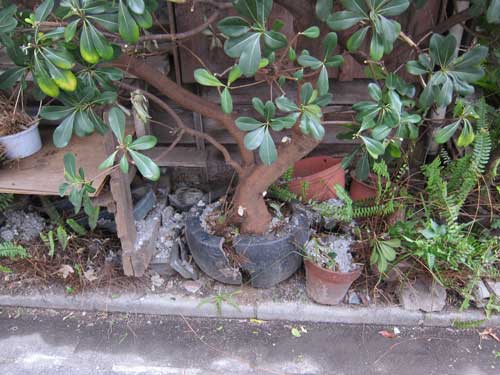

ありきたりの渋谷のビルのなかで、木や石や桜の枝のような自然の素材がおしゃれでなつかしい雰囲気を作っています。
[Date: March 7, 2011]
I love how this ordinary Shibuya building uses minimal natural materials, including wood, stone, and sakura branches, to create an elegant and nostalgic atmosphere.